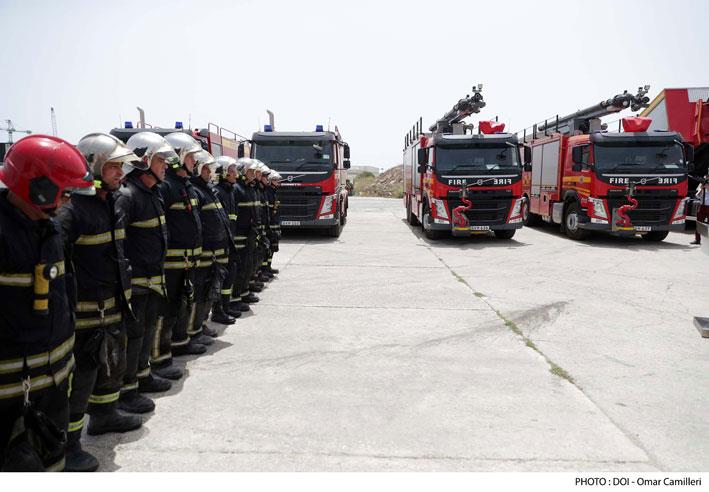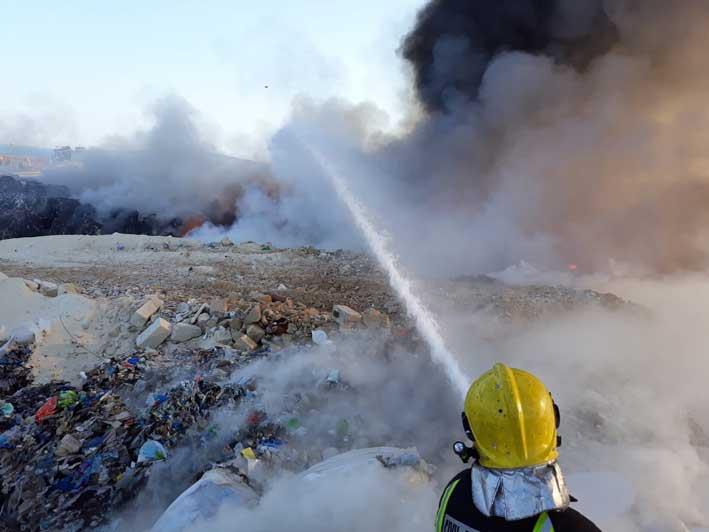There is a misconception that the CPD involves just fire rescue, but there is a lot more to it than that. Would you elaborate further?
Unfortunately, a lot of people do have this perception and it’s something we need to work on. There’s a big difference between the fire brigade unit and civil protection. We have a section that deals with hazardous materials (HAZMAT), we have an urban search and rescue unit and we also have a canine unit. Ultimately, you need to be prepared for any disaster, both natural and man-made. The next step we need to take is to incorporate all our capabilities in the entire department, so we can be there to serve people in the event of any spontaneous incident.
How many people are employed at the CPD?
At the moment, the department is very small. We currently have around 155 fire-fighters, but we will be having a recruitment drive. We have given the government a plan that involves the significant upgrading of infrastructures, such as the introduction of seismic fire stations in the event of earthquakes and a further increase in human resources above and beyond the uptake that is about to take place.
So how many people do you believe the CPD should have?
The plan, which is based on a six-year cycle, states that we need 400 individuals. This means that we would have one fire-fighter for every 1,000 people, which is the standard rate in other countries such as the UK.

The cost of that would probably be high. With the budget coming up, have you spoken with the Minister regarding improved financing for the department?
We have spoken to the Minister regarding the plan, which is a holistic initiative. It has a six-year cycle which continues on to a 10-year plan. It will cost millions, and we are working with experts to ensure that the expense will be spread out gradually, year by year.
We are speaking to experts to examine what should be done in terms of infrastructure. For example, the country requires 10 fire stations that are capable of handling a number of different scenarios, including terrorist attacks for example, which cost almost double the current price tag of around €2 million to €3 million.
We recently saw a significant fire at il-Maqluba in Qrendi during a fireworks display. Without getting into the merits of the activity, do you think enough is being done to ensure proper fire safety on such occasions?
On the issue of fire safety, what I can say is that at the CPD we have prepared the regulations that we want to see implemented and lawyers are currently examining them. There’s a lot of work to be done, as the regulations must be applied differently to varied circumstances. For example, let’s say something as simple as a fire extinguisher: I cannot enforce the same sort of regulations for a grocer as I would for a hotel. The fines and punishments must be higher at the places such as the latter because the fire risks are exponentially greater.
On the case specifically, I won’t get into the specific merits of its causes because I am not a fire investigator. All we know is that there was a fire and we had to deal with the situation.
Firstly, people have to understand that I cannot simply send personnel to a scene to directly combat a fire on the ground because of the risk to their own safety due to the fear of flames encircling them. The first thing we train fighters is that their safety comes first, so it was simply out of the question. We had to approach the area with particular precautions which made fighting fire ineffective. That’s why we took four days. Had the same fire been in a valley, for example, we would have been able to combat it directly and extinguish it within 4 hours.

In the space of a year, we have also seen fires at two waste disposal plants. Does Wasteserv have a problem when it comes to fire safety?
We have to keep in mind that there is a much greater fire risk when it comes to waste, especially considering the combustible nature of certain materials. The difference between the two fires at the waste disposal plants is that the first one was much harder to deal with, so the flames were able to spread and damage the actual infrastructure of the site.
With regard to the second, we managed to extinguish it in four hours, which was due to a number of factors, including environmental conditions such as the direction of the wind. However, the fact that the fire rescue system in place at Wasteserv worked perfectly was crucial to our success. We reached the site immediately and managed to turn on pumps and access continuous water from Wasteserv’s own water supply. The government’s investment in these areas is paying off and we are working with Wasteserv to avoid such incidents in the future.
With regard to the work we have done with Wasteserv, we have noticed that people are disposing of combustible material such as flares in normal waste bags. It is technically not the CPD’s remit, but we are working with Wasteserv so that we can collect such material from their bring-in sites and dispose of it ourselves. This is temporary and we hope to find a more long-term solution.

There has also been a significant increase in the number of high-rise developments, some exceeding 30 floors. Is the country adequately prepared to handle a potentially disastrous situation in one of these developments, let’s say on the scale of Grenfell Tower in London?
High-rises themselves do not worry me; it is high-rise buildings without the proper safety features that do. Unfortunately, in Malta we have a tendency to disregard fire prevention and safety once we need to spend some money. If only people understood the amount it can actually save you, beyond saving your life and your future. The lack of evacuation points, assembly points, sprinkler systems and emergency doors is what worries me.
From our perspective, the equipment needed is highlighted in the plan, such as the introduction of fire engines equipped with a 70m ladder (there are those of 120m, but these would not work in our narrow roads). People tend to assume that the ladder is simply for evacuation, when it is mostly used to get equipment and fire-fighters into the building so they can effectively fight the fire.
Ultimately, accidents will always happen, but proper safety features and exit points can prove crucial in such circumstances. This is the culture we are working to change. The CPD is here to serve and save, and we are prepared to give our lives in order to save the life of someone else, but we need to work on prevention first and foremost. We need to create a culture of discipline in this field. This all starts with our staff at the CPD, who already do a very good job but we need to do more and to lead by example.

Are the legal requirements for safety features in high-rise developments sufficiently robust?
At the moment the Planning Authority asks for our recommendations on certain projects and generally we follow the British standard at the moment. However, we are still trying to push our regulations through. The main problem is enforcement. Let’s say a building does not have an adequate sprinkler system in place: I do not have the power to actually insist on the installation of one. Now, with the new regulations, you can either be fined or given more serious punishments such as temporary closure.
We have also spent a lot of time on education over the last 10 years so that children are able to regard safety features as a basic part of their culture. Ultimately, improvements to infrastructure and equipment are important, but the toughest job is educating people.

The CPD was thrust into the limelight after the Paqpaqli and Plus One incidents, with your predecessor John Rizzo even remarking that, in general, event organisers do not have the adequate safety features in place. Has this situation improved since then?
In both cases, the CPD was put under a huge spotlight. We were bombarded with a number of queries for which we were not prepared. We went from operating as a fire brigade to operating as safety experts and consultants. We are experts in handling the issue head-on, but you need proper consultants and researchers in that particular field. This is why the plan is crucial, because while awareness and structure have improved since then, we need to be able to give a proper answer to people who understandably have questions.
We have worked tirelessly with foreign experts to improve our own capabilities. For example, we sent eight of our personnel to Sweden to become HAZMAT instructors, which means I now have eight such instructors. We have also worked with NGOs to improve our first aid capabilities. The plan, which is state of the art, deals with all of this and includes such features as natural emergency plans, the improvement of training facilities and the introduction of smaller vehicles to deal with our narrow roads – particularly in areas such as Valletta, Birgu and Isla.